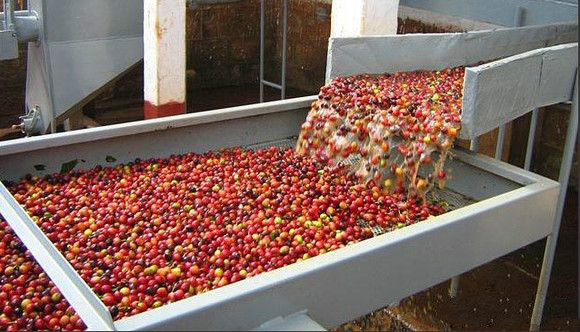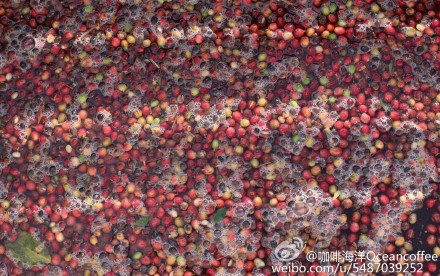Introduction to the treatment of Coffee beans-- washing treatment (Washed)
Because of the lack of sufficient sunshine in the West Indies, the Dutch introduced the "washing method", also known as "WIB", around 1740, which is different from the traditional sun method, also known as "OIB". Coffee beans exported from Java are often marked "WIB", which means "washed beans". The treatment steps of the washing method are as follows:
1. Select beans: put the harvested fruit in a water tank and soak for about 24 hours. At this time, ripe fruit will sink, while immature and overripe fruit will float up and can be removed.
2. Remove the pulp: use a machine to remove the fruit and pulp, leaving only the coffee beans wrapped in endocarp. At this time, there is a layer of mucous membrane on the outside of the beans, and the process of washing is to wash this layer of mucous membrane.
3. Fermentation: the adhesion of the mucous membrane is very strong and it is not easy to remove. It must be placed in the tank for about 18-36 hours to ferment and decompose the mucous membrane. There are two methods of fermentation, namely wet fermentation and dry fermentation. As the name implies, the former adds water and the latter does not add water. In the process of fermentation, the seed and internal pulp will produce special changes, which is a step that most affects the flavor of coffee in water washing. Some farms add hot water or enzymes to speed up fermentation, which has a negative impact on quality and is not popular with selected coffee lovers. Sigri, a famous coffee farm in Papua New Guinea, prides itself on its unique washing method. Their fermentation period lasts for 3 days and is washed with clean water every 24 hours, so they can produce delicious Sigri Coffee.

4. Washing: farms that use the washing method must build washing ponds and be able to introduce an endless supply of live water. During the treatment, the fermented beans are put into the pool and passed back and forth, using the friction of the beans and the power of running water to wash the coffee beans until smooth and clean.
5, drying: after washing, at this time, the coffee beans are still wrapped in the pericarp, the moisture content is up to 50%, must be dried, the moisture content is reduced to 12%, otherwise it will continue to ferment, mildew and rot. The better treatment is to use sunlight to dry, although it takes 1 to 3 weeks, but the flavor is very good and very popular. In addition, some places use to stimulate drying, greatly shorten the processing time, so that the flavor is not as good as sun-dried coffee. The aforementioned Sigri Farm uses the hot equatorial sun to dry its coffee beans. No wonder its Sigri Coffee has won quite a lot of praise in the select coffee market.
6. Shelling: the dried beans can be stored in a warehouse or handed over to the factory for shelling to remove endocarp and silver film.
7. Selection and grading: like the sun-drying method, washed coffee beans are selected and graded to remove defective beans, ensure better quality, and then give them to exporters to sell around the world.
Important Notice :
前街咖啡 FrontStreet Coffee has moved to new addredd:
FrontStreet Coffee Address: 315,Donghua East Road,GuangZhou
Tel:020 38364473
- Prev

Coffee bean water wash coffee treatment coffee bath coffee cherry what is water cleaning
Recently, there are always friends who have just come into contact with coffee to ask, what is the meaning of water washing and sun honey treatment on coffee bean bags? Water washing is not coffee like people bathing with water ah, sunbathing is not people sunbathing, honey treatment is not a fragrant bath ah! Haha, the picture is too beautiful to think about getting back to the point. Let me simply explain the washing of this half bucket of water today.
- Next

The Origin and Development of Coffee flowers the production method of raw milk foam used in the production of coffee flowers
The coffee pull is a change made on the original cappuccino or latte. All people are deeply attracted by the magical and gorgeous skills of coffee flower drawing. Basic explanation 2 about the origin of coffee flower, in fact, there is no very clear literature, only know that at that time in Europe and the United States, coffee flower is in the coffee show, the difficult professional skills, and so on
Related
- What is the meaning of lactic acid fermentation with coffee bean treatment?
- How to judge the state of foam by sound?
- How does the latte pull out the unicorn pattern? Come to get for a little trick to improve the flower pull!
- Will flower pulling affect the taste of the latte?
- Do you know the history of coffee?
- The difference between honey treatment and sun washing what is raisin honey treatment?
- What kind of milk can a novice use to make coffee foam to keep the foam longer? The correct method and skills of milking tutorial sharing
- Why do washed coffee beans taste sour? Flavor characteristics of washed Coffee
- Introduction to the skill of how to practice the size and height of water injection around the circle of hand-brewed coffee
- How do beginners practice coffee flower drawing from scratch?

